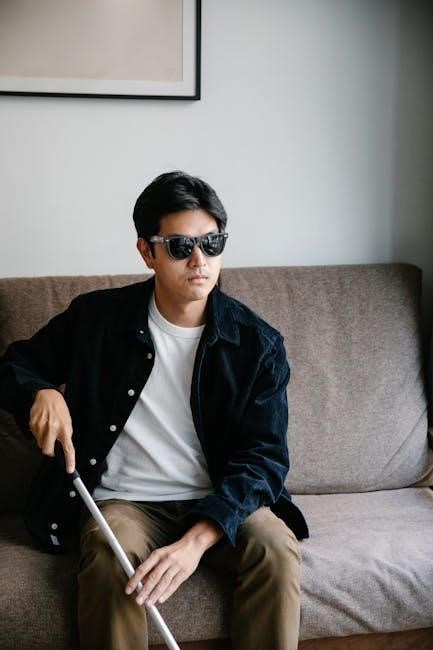Blind running is an empowering sport enabling visually impaired individuals to run independently with sighted guides or technology, fostering inclusivity and physical well-being through accessible participation.
1.1 Historical Overview of Blind Running
Blind running has evolved significantly over the decades, with early efforts focused on creating inclusive opportunities for visually impaired individuals. The mid-20th century saw the rise of organizations dedicated to supporting blind athletes, laying the groundwork for structured running programs. The 1980s marked a turning point with the introduction of guide runners, enabling blind runners to participate in organized races. Technological advancements, such as GPS-enabled wearables, have further enhanced independence. Today, blind running is celebrated globally, with events like the Boston Marathon featuring blind participants. This historical journey highlights the commitment to accessibility and the transformative power of sport for visually impaired individuals.
1.2 The Importance of Inclusivity in Sports
Inclusivity in sports is vital for fostering equality and empowerment, particularly for visually impaired individuals. Blind running exemplifies how inclusive practices can break down barriers, enabling participants to thrive. By integrating resources like guide runners and accessible technology, sports organizations create opportunities for blind athletes to compete and connect. This not only promotes physical well-being but also dismantles stereotypes and fosters a sense of belonging. Inclusive sports environments empower individuals to challenge their limits and inspire others, demonstrating that ability transcends visual impairment. Such initiatives enrich the sporting community by celebrating diversity and promoting shared experiences, ultimately enriching the lives of all participants.
1.3 The Role of Technology in Modern Blind Running
Technology has revolutionized blind running, enhancing independence and safety for visually impaired runners. GPS-enabled apps and wearable devices provide real-time feedback, helping runners navigate routes and track progress. Smartwatches with voice commands offer auditory cues, enabling runners to monitor their pace and distance without sight. Additionally, apps like “Find a Guide” connect blind runners with trained guide runners, fostering collaboration and accessibility. Wearable technology also includes tactile feedback devices, which alert runners to obstacles or changes in terrain. These innovations not only improve performance but also empower runners to participate confidently, breaking down barriers and promoting inclusivity in the sport.
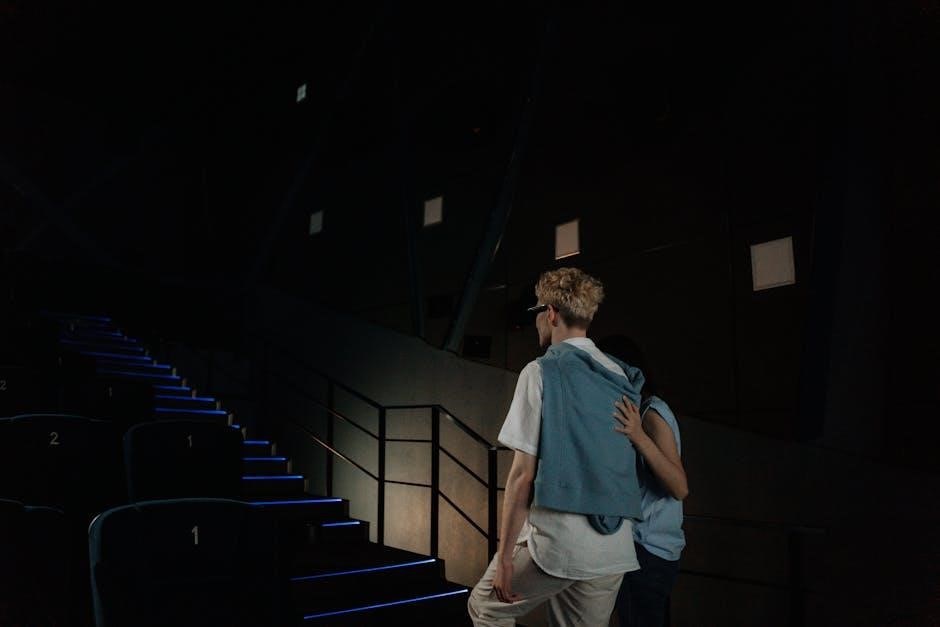
Benefits of Running for the Blind
Running enhances physical health, boosts mental well-being, and fosters social connections for blind individuals, promoting independence, confidence, and a sense of community through inclusive participation.
2.1 Physical Health Benefits
Running offers numerous physical health benefits for blind individuals, including improved cardiovascular health, increased muscle strength, and enhanced mobility. Regular exercise helps maintain a healthy weight, boosts endurance, and strengthens the immune system. For visually impaired runners, consistent training can also improve balance and coordination, reducing the risk of injuries. The physical activity stimulates blood circulation, promoting overall bodily functions and energy levels. Additionally, running can enhance bone density, which is crucial for long-term health. With the support of guide runners or assistive technologies, blind runners can safely engage in physical activity, reaping the same health benefits as sighted runners while gaining independence and confidence in their abilities.
2.2 Emotional and Mental Well-being
Running provides significant emotional and mental benefits for blind individuals, fostering resilience, self-confidence, and a sense of accomplishment. The physical activity releases endorphins, which improve mood and reduce stress. Blind runners experience a profound sense of independence as they navigate challenges, building mental strength and self-efficacy. The supportive relationship with guide runners enhances feelings of trust and camaraderie, combating isolation. Running also offers a therapeutic outlet, allowing individuals to clear their minds and gain a fresh perspective on life. Overcoming obstacles during runs instills a sense of pride and perseverance, contributing to overall emotional well-being and mental health. This empowerment extends beyond running, positively impacting daily life and personal growth.
2.3 Social Connections and Community Building
Blind running fosters strong social connections and community building, creating a supportive network for visually impaired individuals. Guide runners and blind runners form lasting bonds, built on trust and teamwork. Group runs and shared goals encourage collaboration and camaraderie, helping to break down social barriers. Many blind runners join clubs or organizations, where they connect with others who share similar experiences. These communities provide emotional support, practical advice, and a sense of belonging. Celebrating achievements together, whether personal bests or completing a race, strengthens these relationships. The shared joy of running creates a powerful social network, empowering individuals to feel connected and valued. This sense of community is vital for emotional well-being and personal growth.
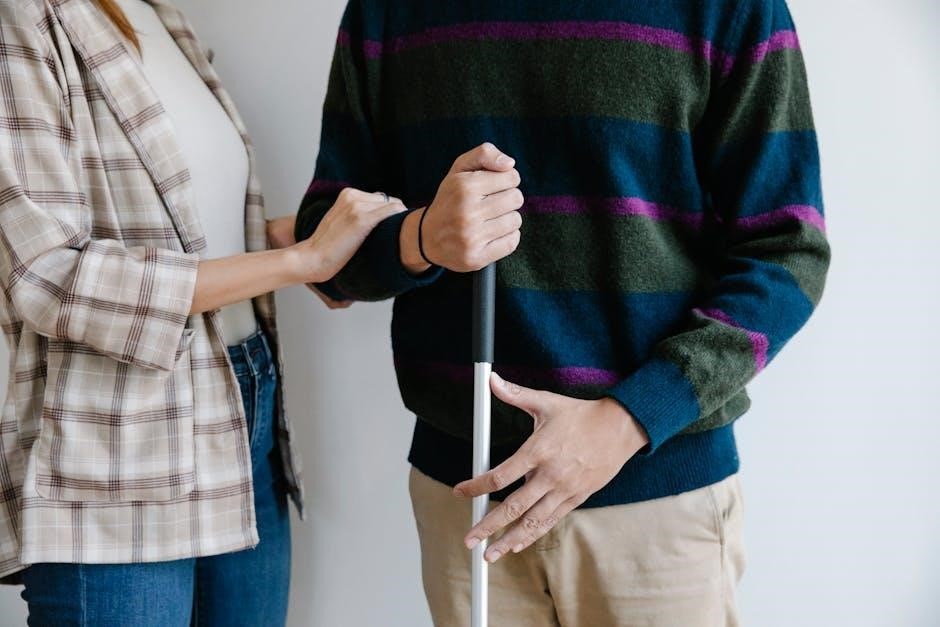
Safety Considerations
Safety is crucial in blind running, relying on guide runners, tethers, and verbal cues to navigate obstacles and terrain effectively, ensuring a secure and confident running experience.
3.1 The Role of Guide Runners
Guide runners play a vital role in enabling visually impaired individuals to run safely and confidently. They provide verbal cues, physical guidance via tethers, and navigation assistance, ensuring obstacle awareness and smooth terrain transitions. Trained guides adapt communication styles to suit individual needs, offering support that fosters independence. Their expertise allows runners to focus on performance while maintaining safety; Guide runners are essential for creating an inclusive running environment, bridging the gap between visual impairment and athletic participation; Their dedication and skill empower blind runners to achieve their full potential, making running accessible and enjoyable for all. Effective guiding builds trust and enhances overall running experiences.
3.2 Use of Tethers and Verbal Cues
Tethers and verbal cues are essential tools for blind runners, ensuring safety and communication. A tether, often a short, adjustable strap, connects the runner and guide, allowing physical guidance and synchronization. Verbal cues, such as “step up,” “turn left,” or “obstacle ahead,” provide critical information about the environment. Guides use clear, consistent tone and volume to ensure clarity. These tools enhance independence, enabling runners to navigate confidently. Proper use of tethers and cues requires practice, building trust between runner and guide. They are vital for safe and effective running experiences, fostering collaboration and empowerment for visually impaired athletes. Both elements are integral to creating an inclusive and accessible running environment. Effective communication is key to success. This approach ensures seamless navigation and shared enjoyment of the sport. The synergy between physical connection and verbal guidance creates a supportive system tailored to individual needs, promoting independence and confidence in blind runners.
3.3 Navigating Obstacles and Terrain
Navigating obstacles and terrain is a critical aspect of blind running, requiring careful planning and communication. Guides provide verbal descriptions of the path, such as uneven surfaces, stairs, or debris, using clear cues like “step up” or “obstacle ahead.” Runners learn to interpret these cues in real-time, developing trust in their guide’s instructions. Tethers also play a role, offering physical guidance to avoid hazards. Additionally, runners may use white canes or sensory awareness to detect terrain changes. Practice and familiarity with routes enhance confidence and safety. Proper training ensures that both runners and guides can effectively navigate various environments, from park trails to urban streets, promoting independence and enjoyment of the sport. Communication and adaptability are key to overcoming challenges. This collaboration ensures a safe and empowering running experience for visually impaired athletes.
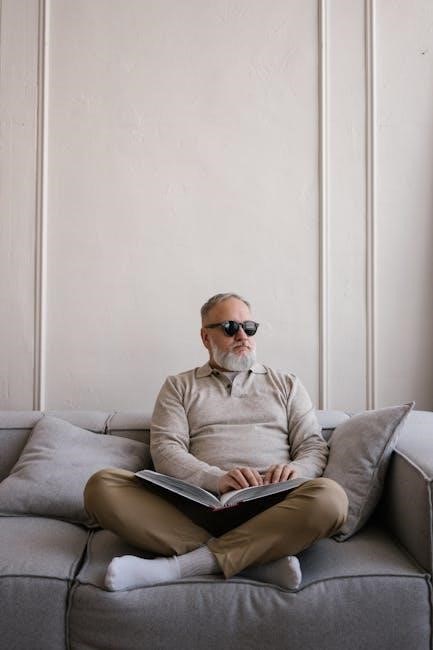
Training and Techniques
Training for blind runners begins with tailored assessments to determine fitness levels and goals. Guide runners provide verbal cues, while technology like apps offers real-time feedback, ensuring safe progress.
4.1 Getting Started: Initial Training
Getting started with blind running involves an assessment of the individual’s fitness level and running experience. A guide runner or coach evaluates the runner’s mobility, balance, and comfort with verbal cues. Initial sessions focus on building trust and communication between the runner and guide. They practice walking, jogging, and stopping while using tethers or verbal commands. The environment is chosen for safety, often starting on flat, obstacle-free paths. This foundational phase ensures the runner feels secure and confident before progressing to more dynamic routines. Technology, like wearable devices, may also be introduced to enhance independence and real-time feedback during training.
4.2 Building a Consistent Routine
Consistency is key to progress in blind running. A regular training schedule helps build stamina, confidence, and trust between the runner and guide. Start with short, manageable sessions, gradually increasing distance and intensity. Incorporate rest days to avoid overtraining and prevent injuries. Use apps and wearables to track progress, set goals, and monitor performance. Feedback from guide runners or coaches is crucial for refinement. Safety remains a priority, with routes planned to minimize obstacles. Over time, adapt routines to suit individual needs, ensuring continuous improvement and enjoyment. A well-structured routine fosters independence and prepares runners for various challenges, whether recreational or competitive.
4.3 Technology in Training: Apps and Wearables
Technology plays a vital role in enhancing the training experience for blind runners. Apps like Find a Guide connect runners with licensed guides, ensuring safe and structured workouts. Wearable devices, such as smartwatches with voice commands, provide real-time feedback on pace, distance, and heart rate. GPS-enabled tools help navigate routes, while apps designed for visually impaired users offer audio cues for obstacle detection; These innovations empower runners to train independently, track progress, and stay motivated. By integrating technology, blind runners can optimize their training routines, set achievable goals, and enjoy a more inclusive and accessible running experience. Technology bridges gaps, fostering confidence and independence in every stride.
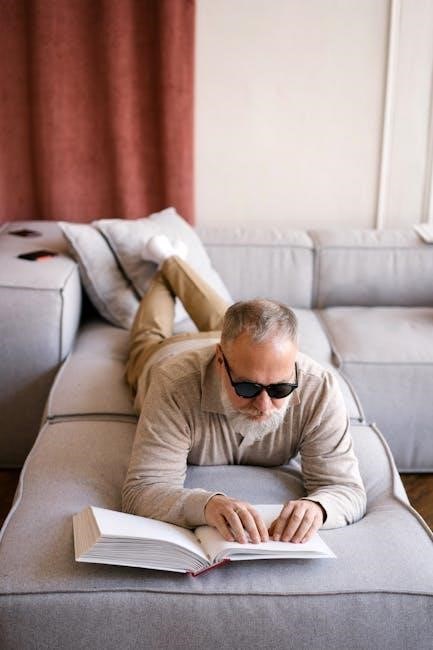
Guide Runners and Their Role
Guide runners provide vital support to visually impaired runners, offering verbal cues, physical guidance, and companionship, enabling safe and enjoyable running experiences through trust and communication.
5.1 How to Become a Guide Runner
Becoming a guide runner involves completing specialized training programs, often offered by organizations like England Athletics and British Blind Sport. These programs teach effective communication, safety protocols, and how to provide verbal cues and physical guidance. Prospective guides must also understand the unique needs of visually impaired runners. Many programs require a background check and first aid certification. Once trained, guides can register with databases like “Find a Guide” to connect with runners. Licensing may also be required, depending on the country or organization. The process emphasizes building trust and ensuring a safe, enjoyable running experience for both the guide and the visually impaired runner.
5.2 Best Practices for Effective Guiding
Effective guiding requires clear communication, trust, and adaptability. Start with a pre-run briefing to discuss the route, pace, and any obstacles. Use verbal cues like “step up,” “narrow path,” or “turning left” to navigate safely. When using a tether, hold it gently but firmly, allowing the runner to maintain balance. Respect the runner’s independence and preferences, adjusting your guidance style as needed. Be attentive to their feedback and stay vigilant for hazards. Encourage and motivate during challenging moments to boost confidence. After the run, debrief to share experiences and improvements. Continuous learning through workshops or feedback enhances your guiding skills, ensuring a safe and enjoyable running experience for both parties.
5.3 Finding a Guide Runner Near You
Finding a guide runner near you is now easier with online resources like the “Find a Guide” database, developed by England Athletics and British Blind Sport. This tool allows individuals with visual impairments to search for licensed guide runners in their area. Simply visit the website, enter your location, and browse available guides. Many guides are volunteers who have undergone training to provide safe and effective support. They use verbal cues, tethers, or other methods to assist runners. If the database doesn’t cover your region, local running clubs or organizations supporting blind athletes may offer alternative connections. Reach out to these groups to find a reliable guide runner and start your running journey with confidence and support.
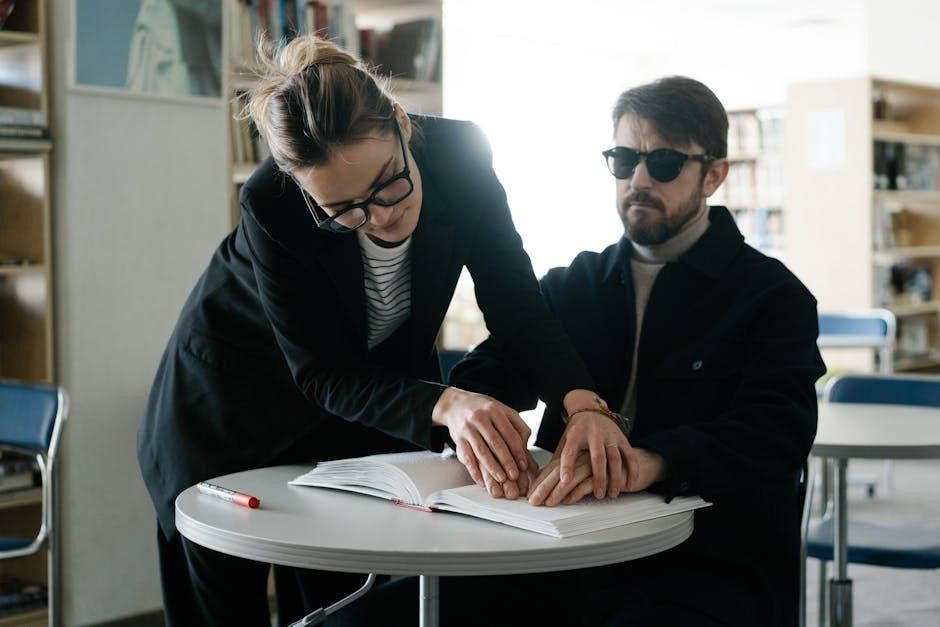
Legal and Accessibility Aspects
Legal rights ensure equal access for blind runners. Accessibility laws mandate inclusive public spaces, promoting safe participation. Advocacy efforts push for better sports infrastructure, fostering inclusivity for all athletes.
6.1 Legal Rights of Blind Runners
Blind runners are protected under various legal frameworks, ensuring equal access to sports and public spaces. The Americans with Disabilities Act (ADA) and similar international laws mandate accommodations, such as guide runners or assistive technology. These rights promote inclusivity and non-discrimination, enabling visually impaired individuals to participate fully in running events. Legal protections also extend to accessible infrastructure, requiring safe pathways and facilities. Advocacy groups often collaborate with legal experts to enforce these rights, ensuring that blind runners can enjoy the same opportunities as their sighted peers. These legal safeguards are crucial for fostering an inclusive and supportive environment for all athletes, regardless of ability.
6.2 Accessibility Laws in Public Spaces
Accessibility laws in public spaces are designed to ensure equal access for all individuals, including blind runners. These laws mandate the implementation of features like tactile pathways, clear signage, and audible signals at crossings. Such provisions enable visually impaired runners to navigate safely and independently. For instance, the Americans with Disabilities Act (ADA) in the U.S. requires public spaces to be accessible, while similar laws in other countries, such as the UK’s Equality Act, enforce comparable standards. These regulations also promote the use of technology, like wayfinding apps, to enhance navigation. Compliance with these laws ensures that public spaces are inclusive, fostering an environment where blind runners can participate fully and safely in their communities.
6.4 Advocacy for Inclusive Sports Infrastructure
Advocacy for inclusive sports infrastructure is crucial to creating accessible environments for blind runners. Organizations and advocates push for facilities equipped with tactile markings, audible signals, and clear pathways, ensuring safe navigation. Campaigns emphasize the importance of adaptive equipment and technology, such as wayfinding apps, to enhance participation. Collaborations between governments, sports bodies, and disability groups drive policy changes and funding for accessible infrastructure. These efforts aim to dismantle barriers, promoting equality and enabling blind runners to fully engage in sports. By prioritizing inclusivity, communities foster a culture of diversity, empowering visually impaired individuals to thrive in athletic pursuits without limitations.
Resources and Support
Resources like national databases, such as “Find a Guide,” connect blind runners with licensed guides, while organizations and apps provide training tools and community support.
7.1 Organizations Supporting Blind Runners
Organizations like England Athletics and British Blind Sport play a crucial role in supporting blind runners by providing resources, training, and connecting them with guide runners. These groups often collaborate with national databases, such as “Find a Guide,” to ensure blind runners have access to licensed guides. Additionally, organizations like the United States Association of Blind Athletes (USABA) offer programs and events specifically designed for visually impaired runners, fostering inclusivity and providing opportunities for participation in sports. These organizations not only promote physical activity but also empower individuals to overcome challenges and build confidence through running.
7.2 National Databases for Guide Runners
National databases, such as “Find a Guide,” play a vital role in connecting blind runners with trained and licensed guide runners. These databases, often developed by organizations like England Athletics and British Blind Sport, allow users to search for guides in their area, ensuring accessibility and fostering independence. By providing a centralized platform, these tools help visually impaired runners find reliable partners for training and participation in events. The databases typically include detailed profiles and contact information, making it easier to build trust and form effective partnerships. Such initiatives are crucial for promoting inclusivity and empowering blind runners to pursue their passion for the sport confidently and safely.
7.3 Apps and Tools for Blind Runners
Apps and tools designed for blind runners enhance independence and confidence. Technologies like GPS navigation apps provide real-time feedback, while fitness trackers offer voice commands for monitoring progress. Applications such as “Find a Guide” connect runners with sighted guides, facilitating partnerships. Additionally, specialized wearables and devices emit tactile or auditory cues, aiding obstacle detection and terrain navigation. These tools not only improve safety but also empower visually impaired individuals to train effectively and participate in races. By integrating assistive technologies, blind runners can enjoy a more inclusive and rewarding experience, bridging the gap between ability and accessibility in the running community.
7.4 Online Communities and Forums
Online communities and forums play a vital role in connecting blind runners and guide runners globally. These platforms offer spaces for sharing experiences, advice, and resources. Many forums discuss training tips, accessibility challenges, and success stories, fostering a sense of belonging. Groups on social media and specialized websites provide opportunities for networking and support. They also serve as hubs for event announcements, such as marathons and workshops. By engaging in these communities, participants gain motivation and practical insights, contributing to a stronger, more inclusive running culture. These online spaces are essential for building connections and promoting the growth of blind running worldwide. They are invaluable for fostering collaboration and mutual encouragement among runners and guides alike.
Personal Stories and Successes
Inspiring journeys of blind runners highlight resilience, growth, and triumph. Their stories showcase how running transforms lives, fostering confidence and empowerment, while inspiring others to embrace the sport.
8.1 Overcoming Challenges: Inspiring Stories
Blind runners face unique challenges, yet their determination and resilience inspire countless individuals. Many have shared their journeys, highlighting how running transforms their lives. For instance, runners who rely on guide runners or technology often speak about overcoming fear and building confidence. One study revealed that visually impaired runners emphasize the emotional and mental growth gained through consistent training. These stories showcase the power of perseverance and the importance of community support. By sharing their experiences, blind runners motivate others to embrace challenges and pursue their passions, proving that vision loss does not limit one’s ability to thrive in sports.
8.2 Famous Blind Runners and Their Journeys
Several blind runners have made remarkable strides in the sport, inspiring others with their determination and achievements. Ness Murby, a Paralympian and advocate, exemplifies resilience, balancing athletics with family life. Tanner Gers, known for his work in adaptive sports, highlights the importance of inclusive training methods. These individuals, along with others, demonstrate how blind runners can excel with the right support, such as guide runners or assistive technology. Their journeys not only showcase personal triumph but also advocate for greater accessibility in sports, proving that vision loss is not a barrier to success. Their stories motivate others to pursue running, emphasizing the power of perseverance and community.
8.3 The Impact of Running on Personal Growth
Running has a profound impact on the personal growth of blind individuals, fostering confidence, resilience, and independence. It challenges perceptions of limitations, empowering runners to embrace new possibilities. Through consistent training and achievement of goals, blind runners develop a strong sense of self-efficacy. The support of guide runners and technology further enhances this journey, building trust and camaraderie. Running becomes more than a physical activity; it’s a transformative experience that cultivates emotional strength and a growth mindset. Many blind runners report increased self-esteem and a deeper connection to their communities, proving that running is a powerful tool for personal development and empowerment.
Blind running embodies empowerment, inclusivity, and joy, proving that running is for everyone. Embrace the journey, seek support, and experience the transformative power of movement and community.
9.1 Summarizing the Journey
The journey of blind running is a testament to resilience and inclusivity, where visually impaired individuals embrace running with the support of guide runners and technology. It highlights the transformative impact of sports on physical health, mental well-being, and social connections. From historical milestones to modern advancements, blind running has evolved into a vibrant community that celebrates diversity and empowerment. The role of guide runners, accessibility laws, and supportive organizations has been instrumental in breaking barriers, ensuring that everyone can experience the joy and freedom of running. This journey underscores the importance of perseverance and the power of community in overcoming challenges and achieving personal growth.
9.2 Final Thoughts and Motivation
Blind running embodies empowerment, proving that vision loss is not a barrier to experiencing the freedom and joy of running. With the right support, such as guide runners and adaptive technology, visually impaired individuals can thrive in this sport. The journey highlights the importance of inclusivity, resilience, and community. Running fosters physical health, emotional well-being, and social connections, enriching lives in profound ways. To those considering this path, remember that every step forward is a victory. Embrace the challenges, celebrate the successes, and let running be a source of strength and inspiration. Together, we can create a more inclusive world where everyone can run with confidence and joy.
9.3 Call to Action for Participation
Join the growing community of blind runners and guide runners transforming lives through the power of running. Whether you’re visually impaired or sighted, there’s a place for you in this inclusive sport. Take the first step by exploring local resources, such as national databases like Find a Guide, to connect with trained guide runners or organizations supporting blind athletes. Embrace the opportunity to challenge yourself, build meaningful connections, and inspire others. Running is more than a sport—it’s a journey of empowerment, personal growth, and community. Let’s run together toward a more inclusive and active future for all!
